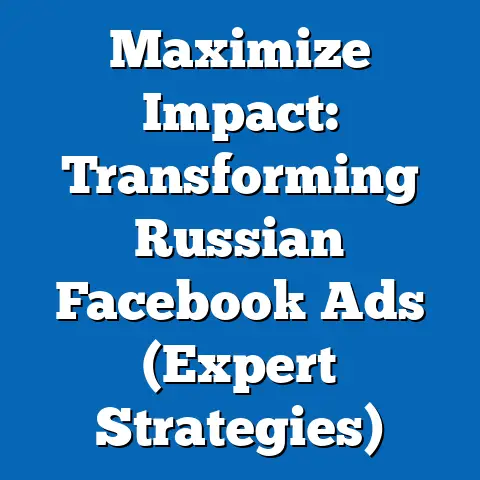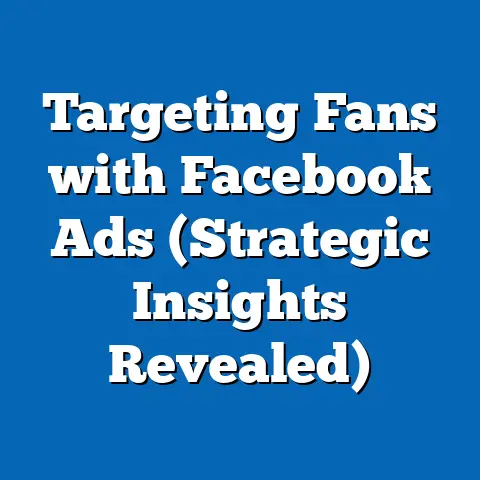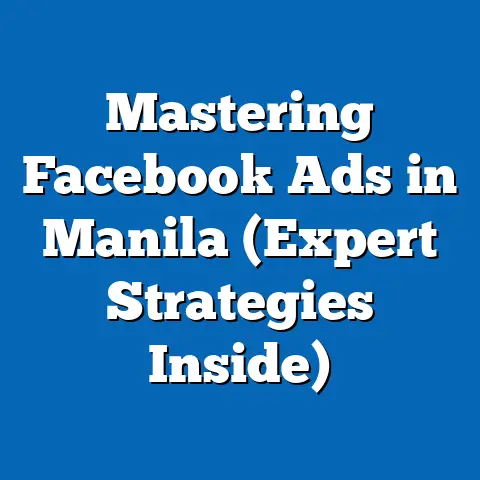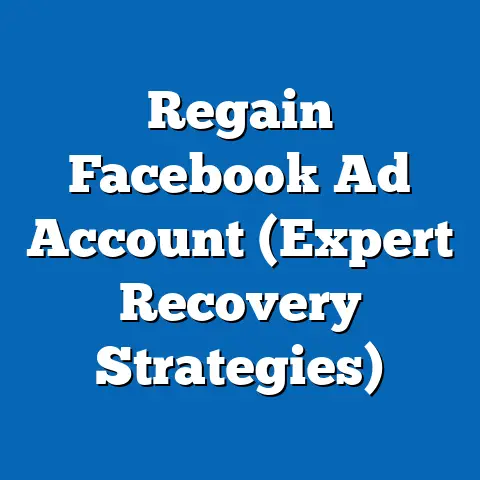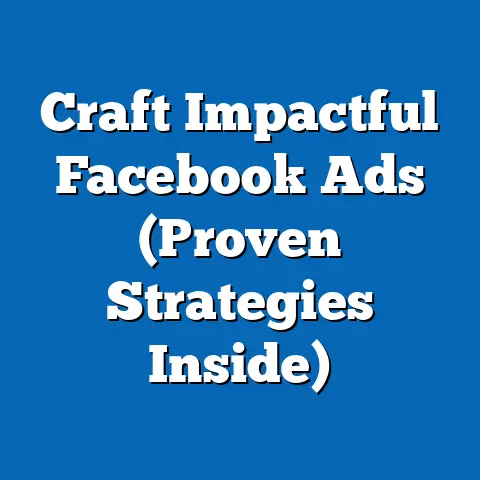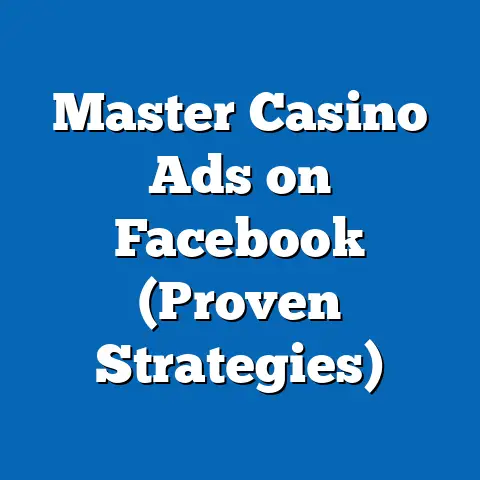Reduce Facebook Ads Costs (Strategic Solutions Unveiled)
Just as our taste buds can distinguish between a gourmet meal and fast food, how can you differentiate between high-performing Facebook ads and those that simply drain your budget? It’s a question I’ve wrestled with countless times in my own digital marketing journey. The sweet taste of a successful campaign, the satisfying ROI, is what we all crave. But too often, we’re left with a bitter aftertaste of wasted ad spend and underwhelming results. This article aims to guide you towards that gourmet experience, helping you craft Facebook ad campaigns that are not only effective but also incredibly cost-efficient.
Introduction
Facebook advertising has become an undeniable cornerstone of digital marketing. With billions of active users, the platform offers unparalleled reach and targeting capabilities. However, as more businesses flock to Facebook to promote their products and services, ad costs have been steadily rising. This presents a significant challenge for marketers, especially those with limited budgets. Simply throwing money at Facebook ads isn’t a sustainable strategy. The key lies in understanding the underlying cost dynamics and implementing strategic solutions to maximize the return on every dollar spent. This article is your roadmap to achieving just that. I’ll unveil proven strategies for reducing your Facebook ad costs while simultaneously boosting the effectiveness of your campaigns.
Understanding Facebook Ads Costs
Before diving into the solutions, it’s crucial to understand the factors that influence Facebook ad costs. Think of it like understanding the ingredients and cooking process before creating a culinary masterpiece. The primary factors include your bid strategy, audience targeting, ad format, and the overall competition within your niche.
- Bid Strategy: Facebook offers various bidding options, such as cost per click (CPC), cost per impression (CPM), and cost per acquisition (CPA). Each strategy has its own advantages and disadvantages, and the optimal choice depends on your campaign goals and budget. For example, if you’re focused on driving website traffic, CPC bidding might be the most appropriate. However, if brand awareness is your primary objective, CPM bidding could be more cost-effective.
- Audience Targeting: The more specific and niche your target audience, the higher the potential cost. This is because you’re competing with other advertisers who are targeting the same highly desirable demographics. Conversely, a broader audience might be cheaper to reach, but it could also result in lower conversion rates.
- Ad Format: Different ad formats, such as image ads, video ads, and carousel ads, have varying costs associated with them. Video ads, for instance, tend to be more expensive than image ads due to the higher production costs and increased engagement they typically generate.
- Competition: The level of competition within your industry or niche significantly impacts ad costs. If you’re in a highly competitive market, you’ll likely have to bid higher to secure ad placements.
The Facebook Ads Auction
At the heart of Facebook advertising lies the Facebook Ads Auction. It’s a real-time, automated system that determines which ads are shown to users and at what price. When a user visits Facebook, the platform instantly evaluates all eligible ads based on factors like bid amount, ad quality, and estimated action rates. The ads with the highest overall value win the auction and are displayed to the user. This auction dynamic means that your ad costs are constantly fluctuating based on the interplay of these factors. Understanding this mechanism is key to optimizing your campaigns for cost-effectiveness.
Takeaway: Understanding the factors that influence Facebook ad costs, including bid strategy, audience targeting, ad format, and competition, is crucial for effective cost management.
Strategic Solutions to Reduce Costs
Now that we have a solid understanding of the cost drivers, let’s explore some strategic solutions to reduce your Facebook ad costs. These aren’t just quick fixes; they’re fundamental principles that, when applied consistently, can lead to significant savings and improved campaign performance.
A. Optimize Audience Targeting
One of the most impactful ways to reduce Facebook ad costs is to refine your audience targeting. Think of it as sharpening your aim before taking a shot. The more precise your targeting, the less money you’ll waste on showing ads to irrelevant users.
- Identify and Narrow Down Target Audiences: Start by thoroughly researching your ideal customer. What are their demographics, interests, behaviors, and pain points? The more you know about your target audience, the better you can define them within Facebook’s Ads Manager. Don’t be afraid to get granular. Instead of targeting “small business owners,” try targeting “small business owners in the tech industry who use project management software.”
- Utilize Facebook’s Audience Insights Tool: Facebook’s Audience Insights tool is a treasure trove of data that can help you understand your target audience on a deeper level. This tool provides valuable insights into demographics, interests, page likes, and location data. By analyzing this information, you can identify hidden interests and behaviors that you might not have considered otherwise. For example, I once discovered that a significant portion of my target audience for a marketing automation product was also interested in a specific type of productivity podcast. This allowed me to refine my targeting and reach a highly engaged audience at a lower cost.
- Create Lookalike Audiences: Lookalike Audiences are one of Facebook’s most powerful targeting features. They allow you to reach potential customers who share similar characteristics with your existing customers. You can create Lookalike Audiences based on your website visitors, email subscribers, or even your Facebook page fans. This is a highly effective way to expand your reach while maintaining a high level of relevance. I’ve personally seen Lookalike Audiences outperform interest-based targeting by a significant margin in terms of both cost and conversion rates.
My Experience with Audience Optimization:
I remember working with a client who was struggling with high Facebook ad costs. They were targeting a broad audience with generic messaging, and their results were underwhelming. After diving deep into their customer data and utilizing Facebook’s Audience Insights tool, we discovered that their most profitable customers were actually a niche segment within their broader target audience. We created a Lookalike Audience based on their existing customer data and launched a new campaign with tailored messaging. The results were remarkable. Their ad costs plummeted, their conversion rates soared, and their overall ROI improved dramatically. This experience solidified my belief in the power of audience optimization.
Takeaway: Optimizing your audience targeting is a critical step in reducing Facebook ad costs. By identifying and narrowing down your target audiences, utilizing Facebook’s Audience Insights tool, and creating Lookalike Audiences, you can reach the right people at the right price.
B. Improve Ad Relevance and Quality
Facebook rewards ads that are relevant and engaging to users. The higher your ad’s relevance score, the lower your costs will be. Think of it as Facebook giving you a discount for providing a positive user experience.
- Understand the Relevance Score: The relevance score is a metric that Facebook uses to assess the quality and relevance of your ads. It’s based on factors like user feedback, engagement rates, and post-click experience. A high relevance score indicates that your ad is resonating with your target audience, while a low score suggests that it’s not.
- Improve Ad Creatives: Your ad creatives, including visuals, copywriting, and calls-to-action, play a crucial role in determining your ad’s relevance score. Use high-quality images and videos that are visually appealing and relevant to your target audience. Write compelling ad copy that clearly communicates your value proposition and addresses your audience’s pain points. And include a clear and concise call-to-action that encourages users to take the desired action.
- A/B Testing: A/B testing, also known as split testing, is the process of testing different variations of your ads to determine which ones perform best. This is an essential practice for improving your ad relevance and reducing your costs. Test different headlines, images, ad copy, and calls-to-action to see what resonates best with your audience. Even small changes can have a significant impact on your ad’s performance.
My A/B Testing Success Story:
I once ran an A/B test on a Facebook ad campaign for an e-commerce client. We tested two different headlines: “Shop Our New Collection” and “Get 20% Off Your First Order.” The “Get 20% Off Your First Order” headline significantly outperformed the “Shop Our New Collection” headline in terms of click-through rate and conversion rate. This simple change resulted in a dramatic reduction in our ad costs and a significant increase in our sales. This experience taught me the importance of continuous A/B testing and optimization.
Takeaway: Improving ad relevance and quality is crucial for reducing Facebook ad costs. By understanding the relevance score, improving your ad creatives, and conducting A/B testing, you can create ads that resonate with your target audience and drive better results.
C. Leverage Retargeting Campaigns
Retargeting is the practice of showing ads to users who have previously interacted with your brand. This is a highly effective strategy for reducing Facebook ad costs because you’re targeting users who are already familiar with your brand and are more likely to convert.
- Reach Users Who Have Interacted with Your Brand: Retargeting allows you to reach users who have visited your website, watched your videos, or engaged with your Facebook page. These users have already expressed an interest in your brand, making them a highly qualified audience.
- Cost-Effectiveness of Retargeting: Retargeting is often more cost-effective than acquiring new customers because you’re targeting users who are already in your sales funnel. These users are more likely to convert, resulting in a higher return on your ad spend.
- Examples of Effective Retargeting Strategies:
- Dynamic Ads: Dynamic ads are personalized ads that automatically show users products they’ve previously viewed on your website. This is a highly effective way to re-engage users and drive sales.
- Tailored Messaging: Tailor your retargeting messaging to the specific actions users have taken on your website or Facebook page. For example, if a user added a product to their cart but didn’t complete the purchase, you could show them an ad with a special discount code.
- Dynamic Ads: Dynamic ads are personalized ads that automatically show users products they’ve previously viewed on your website. This is a highly effective way to re-engage users and drive sales.
- Tailored Messaging: Tailor your retargeting messaging to the specific actions users have taken on your website or Facebook page. For example, if a user added a product to their cart but didn’t complete the purchase, you could show them an ad with a special discount code.
My Retargeting Revelation:
I used to underestimate the power of retargeting. I thought it was just a way to annoy people with ads. But after implementing a well-crafted retargeting campaign for a lead generation client, I realized how wrong I was. We targeted users who had visited their website but hadn’t filled out a lead form. We showed them ads with compelling testimonials and a clear call-to-action. The results were astounding. Our lead generation costs plummeted, and our conversion rates skyrocketed. This experience completely changed my perspective on retargeting.
Takeaway: Retargeting is a powerful strategy for reducing Facebook ad costs. By reaching users who have previously interacted with your brand, you can increase your conversion rates and improve your overall ROI.
Tracking and Analyzing Performance
No strategy is complete without proper tracking and analysis. Think of it as a chef constantly tasting and adjusting the seasoning while cooking. Monitoring your campaign performance is crucial for identifying what’s working and what’s not.
- Utilize Facebook’s Ads Manager: Facebook’s Ads Manager is your central hub for tracking and analyzing your campaign performance. It provides a wealth of data on metrics like impressions, clicks, conversions, and cost per result.
- Monitor Key Performance Indicators (KPIs): Focus on monitoring key performance indicators (KPIs) that are relevant to your campaign goals. These might include:
- ROAS (Return on Ad Spend): Measures the revenue generated for every dollar spent on advertising.
- Conversion Rates: Measures the percentage of users who take the desired action, such as making a purchase or filling out a lead form.
- Engagement Levels: Measures the level of interaction users have with your ads, such as likes, comments, and shares.
- Regular Analysis of Campaign Data: Regularly analyze your campaign data to identify trends and areas for improvement. Look for patterns in your data that can help you optimize your targeting, creatives, and bidding strategies.
- ROAS (Return on Ad Spend): Measures the revenue generated for every dollar spent on advertising.
- Conversion Rates: Measures the percentage of users who take the desired action, such as making a purchase or filling out a lead form.
- Engagement Levels: Measures the level of interaction users have with your ads, such as likes, comments, and shares.
My Data-Driven Decision-Making:
I always make it a point to review my Facebook ads data at least twice a week. This allows me to identify any potential issues early on and make adjustments before they impact my campaign performance. For example, I once noticed that my ad costs were increasing significantly on certain days of the week. After analyzing the data, I realized that this was due to increased competition from other advertisers. I adjusted my bidding strategy to compensate for the increased competition, and my ad costs quickly returned to normal.
Takeaway: Tracking and analyzing your campaign performance is essential for optimizing your Facebook ad campaigns and reducing your costs. By utilizing Facebook’s Ads Manager and monitoring key performance indicators, you can make data-driven decisions that improve your results.
Conclusion
Reducing Facebook ad costs is not about cutting corners; it’s about working smarter. By understanding the underlying cost dynamics and implementing strategic solutions, you can create Facebook ad campaigns that are not only effective but also incredibly cost-efficient. Remember, the key lies in optimizing your audience targeting, improving your ad relevance and quality, leveraging retargeting campaigns, and continuously tracking and analyzing your performance.
I encourage you to implement these strategies and actively seek out opportunities for cost reduction in your Facebook advertising efforts. The sweet taste of a successful, cost-effective campaign is well worth the effort. Now, go out there and create some culinary masterpieces of your own!

